You’ve heard of purple shampoo, which works to neutralize the brassy and yellow tones that come from bleaching or coloring your hair. However, it is typically used on wet hair, so can it be used on dry hair? And what do you need to do when putting purple shampoo on dry hair?
To use purple shampoo on dry hair, purchase a purple shampoo that is sulfate-free and is meant to be used by the hair type it will be used on, and set aside time to apply the purple shampoo and let it process. The purple shampoo will take about 20 to 40 minutes to process fully.
Below is a step-by-step guide for using purple shampoo on dry hair, so keep reading!
Table of Contents
Before You Start: When to Apply Purple Shampoo to Dry Hair vs Wet Hair
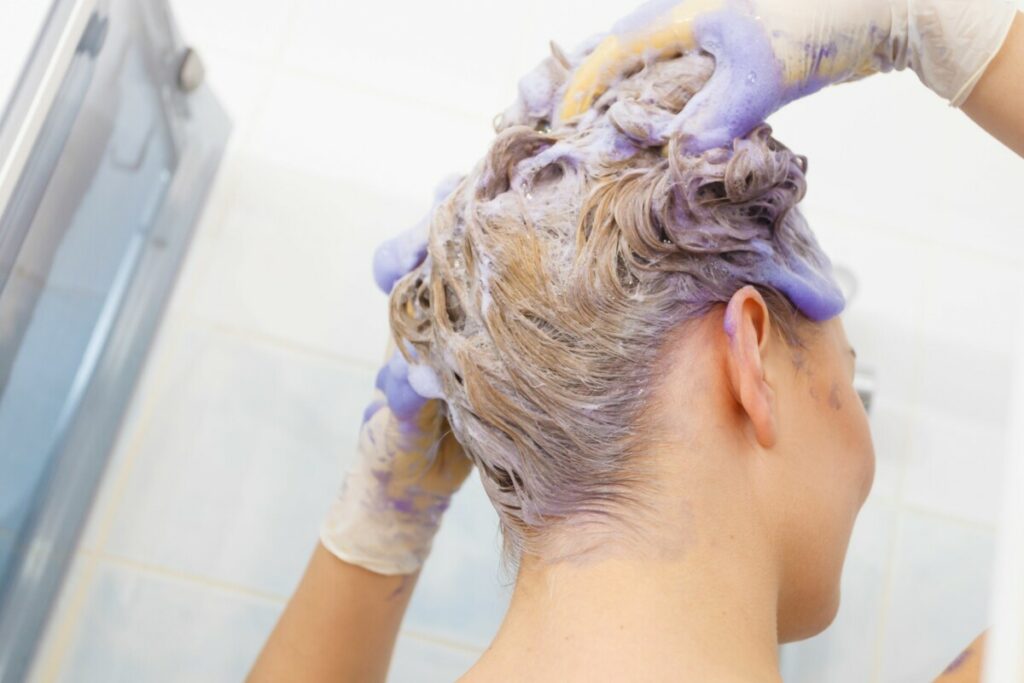
Before applying purple shampoo to your dry hair, you should know when it is or isn’t the best idea to apply it. When it’s not quite as safe to use, such as on damaged or brittle hair, it’s best to use the traditional and recommended method of applying purple shampoo.
To determine whether or not the purple shampoo will be safe to apply directly to your dry hair, you should examine your hair to see if it is dry in texture or is able to retain moisture well. If it’s able to retain and absorb moisture well, it is generally healthier. You can usually tell if your hair is dry by whether or not it is shiny.
If there isn’t much shine to it and the hair breaks easily, it’s likely too dry to handle the effects of purple shampoo, and the purple shampoo toning properties may cause even more damage to your hair.
You should also examine your hair shafts to see how porous it is to further determine how dry or healthy your hair is. If your hair shafts are highly porous, they will absorb more moisture and product than hair that has low porosity. Low porosity hair that has been treated with purple shampoo is more likely to leave a purple sheen because it didn’t absorb much of the product, so you’ll be left with this purple, yellow hair that is less than ideal.
If your hair appears very dry and brittle, it’s probably also low porosity because of hair damage that prevents it from being able to hold in moisture and nutrients from your everyday shampoo and conditioner. In this case, you’ll want to wet your hair before applying purple shampoo to it so that it can better absorb the shampoo with that extra hydration from the water.
Warnings for Using Purple Shampoo on Dry Hair
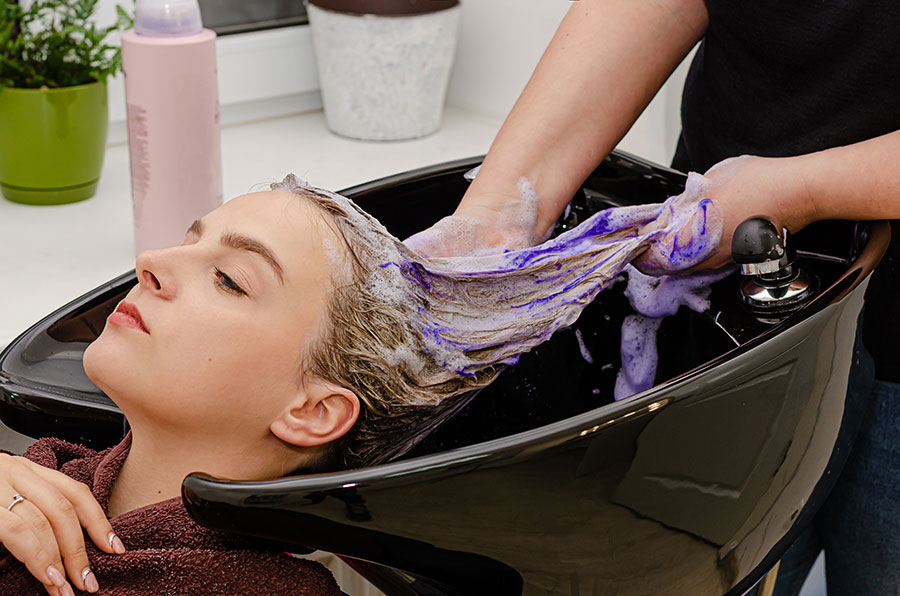
While using purple shampoo directly on dry hair can help your hair to better absorb the product and to further neutralize those yellow tones to achieve that cool-toned hair color with fewer applications, there are some risks to using it without wetting your hair first.
The first risk is that because almost everyone’s hair has dry patches or sections of their hair that are dryer than others, especially at the ends of the hair, the toning job on your hair can end up uneven and blotchy.
The uneven distribution of dry and moist sections of hair shafts can leave your hair with random leftover spots of yellow hair where it couldn’t absorb quite as much of the product. Many people may not mind this effect, especially if they’re going for a textured, brown-to-blond ombre look, but the blotchiness can be a bit unpredictable.
If you decide you want to take the risk and try out applying purple shampoo to dry hair, there are ways that you can minimize this blotchiness, which we will go into greater depth later on in this step-by-step guide. The first thing you can do is examine your hair to see how healthy your hair is, which can then help you decide how long you’ll leave the purple shampoo on your hair.
If your hair has signs of drying, such as dull color, brittle hair shafts, frizziness, lackluster appearance, or coarse texture, you’ll either want to use the traditional wet hair purple shampoo method or leave it on your dry hair for only 5 minutes.
If your hair is very healthy, strong, and shiny, this means it can maintain more moisture and can withstand longer direct exposure to the product, so you can leave it in for up to 30 minutes for better neutralization, but we recommend closer to 20 minutes.
Step 1: Find the Best Purple Shampoo for Your Hair Type
The first thing you’ll want to do is find a purple shampoo that will work best for your hair type. There are many brands of purple shampoo on the market, but you’ll want to find a purple shampoo that is free of sulfates and parabens and is targeted to your hair type.
While shopping, read the front and back descriptions to see if the bottle tells you which hair type the brand recommends it for and whether it’s best for natural blondes, color-treated hair, or bleach-colored blondes. Natural hair types you might see mentioned on the bottle include straight, wavy, curly, and coiled/kinky hair, as well as dry, thick, and thin hair.
Regardless of your hair type, you’ll also want to ensure that the purple shampoo has extra moisturizing properties since you’ll be applying it directly to your dry hair. If it has these properties, it will be clearly labeled as “moisturizing.” This will assist your hair in absorbing the content without drying out your hair.
Step 2: Prepare Your Workstation and Clothes
Whether you’re applying your purple shampoo on your hair over the bathroom sink or over the tub, you’ll want to prepare your workstation with your bottle of purple shampoo, a towel, and rubber gloves. Purple shampoo can stain the ceramic of your bathroom sink and tub if not cleaned up quickly enough, so be prepared for any spills you might need to clean up using water and a paper towel.
You’ll also want to drape a towel over your shoulders and adjust it to cover your neck. This will help prevent the purple shampoo from staining your skin or your clothes. If you’re worried about the purple tint staining the skin below your hairline, especially if you plan to tone your roots, take a bit of Vaseline and rub it on the skin just below your hairline.
Step 3: Brush Through and Detangle Your Hair
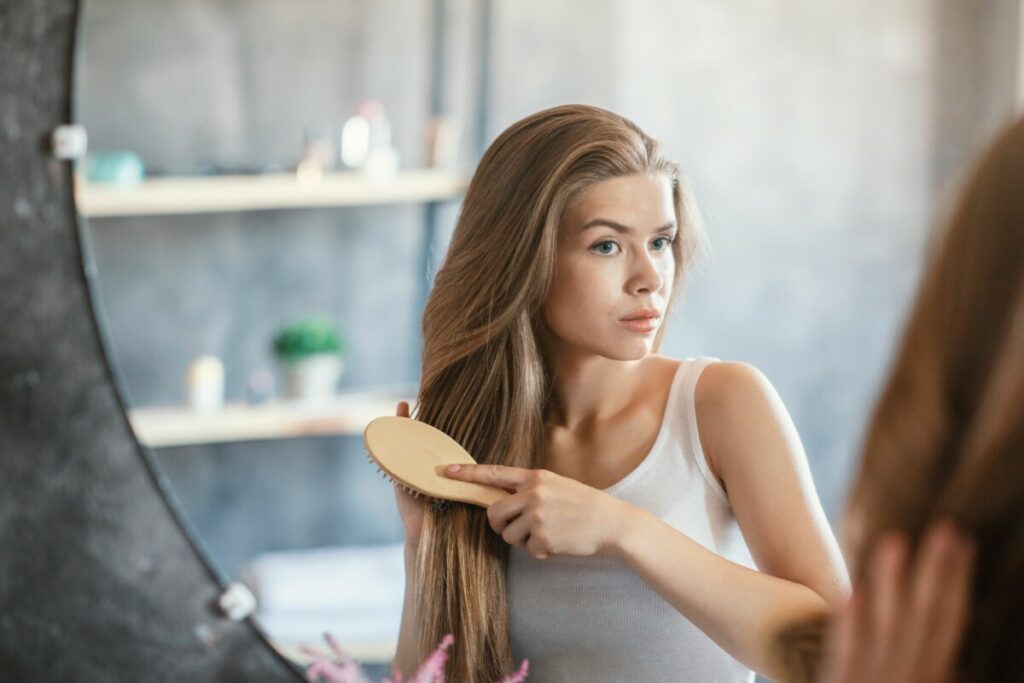
Next, you’ll need to take a hairbrush or comb and run it through your hair to help detangle it. Having detangled and smooth hair will help the purple shampoo penetrate each hair shaft evenly. If you have curly or coiled hair, we recommend using a small amount of hair oil to smooth out your hair and to help separate any tangles, then going through it with a tooth comb.
Related Article: Different Types of Hair Brushes
Step 4: Put on Your Rubber Gloves
The next thing you’ll want to do is prepare your hands for the project by putting on rubber gloves. These will keep your hands from getting stained purple by the shampoo, and you’ll also want to put these on when it comes time to rinse your hair out.
We recommend using disposable rubber or plastic gloves that often come with hair color or that you can purchase by the box.
Step 5: Add Hair Conditioner to the Tips of Your Hair
Because purple shampoo has a harder time penetrating hair that is dry or doesn’t retain as much moisture, we recommend massaging a small pump of hair conditioner to the tips of your hair, about an inch up from the ends.
This is because your ends tend to get the driest (hence why we get split ends), and the conditioner will help the purple shampoo to penetrate the dry ends better, so more of that brassy color gets removed.
Step 6: Apply Purple Shampoo to Small Sections of Dry Hair
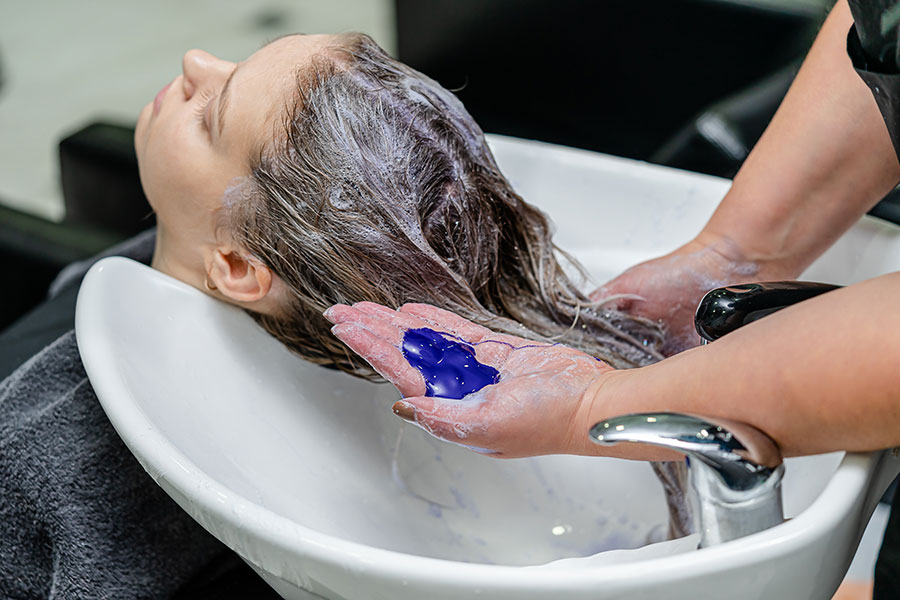
Using your comb, split your hair into small sections to work the purple shampoo into your hair. We recommend parting your hair down the middle and then taking a small section from the front on one side.
While grasping that section, put a small amount of purple shampoo into your other hand and begin working the shampoo into your hair, starting at the ends and working your way up. Add more purple shampoo as needed.
After each section, use your comb to divide your hair into more sections, gradually working your way down over the crown of your head and down to your neck.
Step 7: Comb through Your Hair
After you’ve worked the purple shampoo in each section, rubbing it in to ensure that you coat each individual hair shaft, you’ll want to take your comb and comb through each section as you go, especially if your hair is straight. If your hair is coiled, you can comb through it with your fingers instead.
Do this to every section as soon as you’ve finished coating the hair up to where your blonde or brassy color begins at your roots.
Step 8: Clip Up Hair Sections as You Go
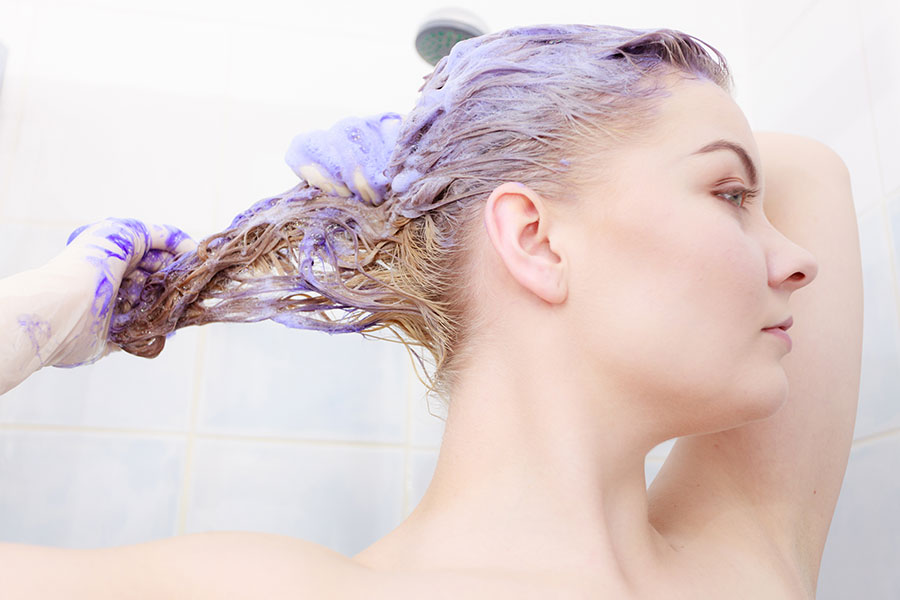
As you work the purple shampoo into each hair section and comb through it, we recommend pinning or clipping your hair up in separate sections as you go using alligator clips, claw clips, or bobby pins. This is much like the process of coloring your hair a new color. As we mentioned in step 6, you’ll want to start at the top front of your head so that clipping each section will be easy.
Start with a section at one side of your part, then move to the other side, alternating sides as you work your way down. To clip your hair sections up, twist the hair by twirling it with your finger until it curls into itself and sits flat against your head, then pin or clip it down.
Step 9: Wrap Your Hair So it’s Out of the Way
Next, you’ll want to wrap your hair with either a shower cap, a plastic bag, or a cloth bandana that you don’t mind getting stained. You’ll wrap it so that it fits snuggly around the perimeter of your hairline while your hair is already pinned up.
If you opt against pinning your hair up, you can tie up all your hair into a bun before covering your head with the shower cap or other covering. The covering will help protect the hair and keep those pins (or the hair bun) from falling out while your hair absorbs the purple shampoo. This will also prevent the purple shampoo from transferring onto your hands or other things.
Step 10: Set Your Timer
Once your hair is wrapped up and out of the way, take off your gloves and set a timer according to the health of your hair. If your hair is very dry, you’ll want to leave the purple shampoo in longer than if it is very healthy and retains moisture well. Depending on how dry or healthy your hair is, you’ll leave the purple shampoo for 5 to 30 minutes.
Healthier, moisture-retaining hair will do just fine by having the purple shampoo soaking into the hair for 5 or 10 minutes. Dryer, brittle hair that doesn’t hold moisture well will need to absorb the purple shampoo for 20-30 minutes.
If you’re unsure of the health of your hair, we recommend setting your timer for 15 minutes. This will be a good time to clean up any purple shampoo drips or stains left on your bathroom sink, tub, or floor so that it doesn’t dry too much.
Step 11: Remove the Hair Wrap and Rinse Your Hair
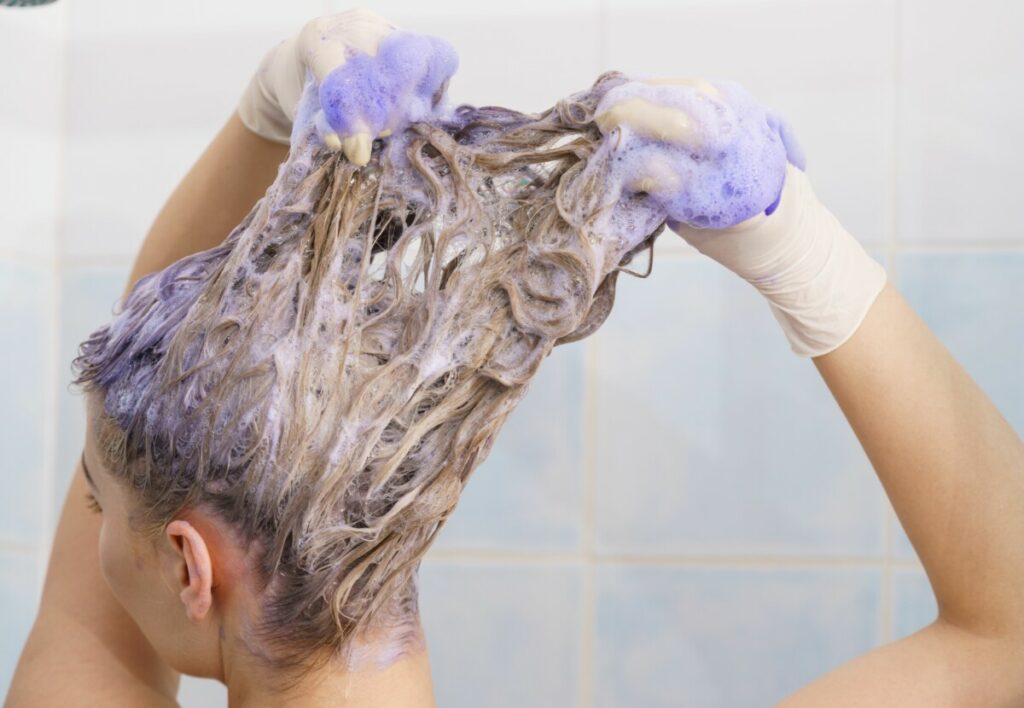
Once your timer goes off, remove your clothing, then remove the hair wrap and all of your hair pins or clips. Then, step into the shower and rinse all the purple shampoo from your hair. You can also do this over the sink without undressing, but it may get messy. You can use a wide-tooth comb to assist in getting all the purple shampoo out.
Step 12: Apply Hair Conditioner
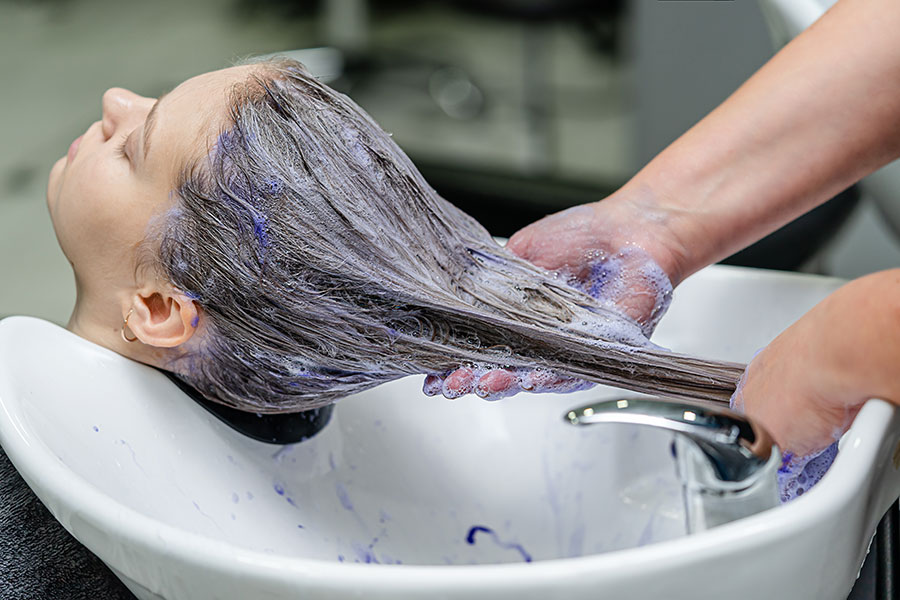
Once all the purple shampoo is rinsed out and the water running over your head no longer runs a tinge of purple, you’ll want to apply a good moisturizing hair conditioner to your hair. This will help stimulate your hair shafts and moisturize them, as well as completely wash away the rest of the purple shampoo.
Step 13: Clean Up Your Tub and Workstation
After you dry off and dress, you’ll probably notice that there is leftover purple shampoo residue on your tub or bathroom sink. Before it dries completely, you’ll want to clean it up quickly using a wet washcloth or sponge and a mild bathroom cleaner. Throw away your used gloves, used paper towels, and shower cap or hair wrap.
Step 14: Dry and Style Your Hair
To fully see the effect of the purple shampoo on your hair and how well it toned, we recommend using a blow dryer to dry your hair. Once dry, you can examine it to see if the purple shampoo did the trick and gave you the results you wanted.
You’ll likely find that using the purple shampoo on your dry hair was able to do a better job than doing repeated washes of purple shampoo on wet hair. If the color is still a bit too brassy or yellow to your liking, you can repeat these steps again tomorrow.
If the color turned out too ashy or with a sheen of purple on the hair shafts, you can wash your hair once more with a clarifying shampoo, which will help get rid of these tones.
Step 15: Deep Condition Once Per Month
After the purple shampoo treatment, we recommend using a deep conditioner about one month later and once every month following. The deep conditioner will add moisture and vitamins that your hair may have lost during the hair bleaching and purple shampoo treatment process.
You can even start your deep conditioning right away if you feel like your hair is already a bit dull from the bleach and coloring. By deep conditioning, you’ll get that extra beautiful blonde or golden shine in no time.



